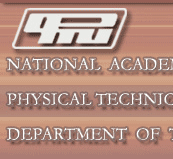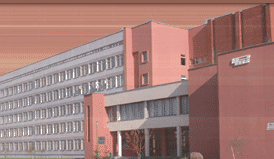|
1. Our
proposal
2. Characteristics
of the equipment
3. Our
partners
4. Interesting
technologies
5. Literature
6. Conferences
1.
OUR PROPOSAL
1.1. Delivery of
the equipment including second hand one;
1.2. Delivery of rolled parts;
1.3.
Delivery of the drawings of the equipment;
1.4. Training of specialists;
1.5.
Service;
1.6. Delivery of know-how;
2.
CHARACTERISTICS OF THE
EQUIPMENT.
For the
implementation of the CWR process in the
automatic mode of operation the Physical
Technical Institute of the National Academy of
Sciences of Belarus has worked out universal
equipment which includes:
Х a charging
device;
Х a heating device;
Х a CWR
mill;
Х means of mechanization and
automation.
On table 1 the technical
characteristics of the CWR complexes constructed
by the Physical Technical Institute of the
National Academy of Sciences of Belarus are
shown.
2.1. SIZE OF PARTS

Table
1
Technical
Characteristics of the Cross-Wedge Rolling
Complexes
|
Parameters |
Model |
|
PM5.135 |
PM5.155 |
PM5.150 |
PM5.550 |
PM5.117 |
PM5.095 |
|
Maximum
strengthening of rolling, kN |
250 |
300 |
200 |
70 |
150 |
100 |
|
Slide stroke,
mm |
2800 |
2200 |
2650 |
1900 |
1900 |
1400 |
|
Number of sliders |
2 |
2 |
1 |
1 |
1 |
1 |
|
Length of the tool,
mm |
2500 |
2000 |
1250 |
900 |
900 |
600 |
|
Productivity,
strokes/hour |
180 |
240 |
240 |
600
720* |
300 |
600 |
|
Dimensions of a
rolled blank, mm
-diameter
-length |
60...120 up to 1000 |
60...120 up to 860 |
50...110 up to 520 |
30...60 up to 350 |
33...50 up to 250 |
14...25 up to 160 |
|
Main drive power,
kW |
120 |
130x2 |
90 |
75 |
60 |
60 |
|
Induction heater
power, kW |
800 |
250 |
250 |
- |
250 |
100 |
|
Frequency of
current feeding the induction heater,
Hz |
1000 |
2400 |
2400 |
- |
2400 |
8000 |
|
Heater
temperature of blanks, ∞— |
900... 1200 |
900... 1200 |
900... 1200 |
900... 1200 |
900... 1200 |
900... 1200 |
|
Cooling water
consumption, m3/h |
50 |
5...10 |
1...10 |
1...12 |
1...12,5 |
1...10 |
|
Servicing staff,
persons |
1 |
1 |
1 |
1 |
1 |
1 |
|
Dimensions,
mm
-length
-width
-height |
16000
8000
1700 |
7660
3000
2360 |
5600
2500
3100 |
5600
4200
1700 |
9500
6700
2750 |
7500
4500
2200 |
|
Mass, kg |
40000 |
40000 |
19000 |
8000 |
25000 |
12000 | |
* - when using foreign hydraulic system for a mill
Installation does
not require a base!!!
Guarantee period - one year
2.2. THE COUNTRIES
WHERE THE BELARUSIAN EQUIPMENT WORKS
The
countries which use the offered equipment are
Belarus, Russia, the Ukraine, Bulgaria, Poland, the Czech Republic, Germany, Italy, Spain, Turkey, the USA, Mexico, India and South Korea.
2.3. FIELDS OF
APPLICATION.
The CWR is used in
automobile, machine-building, instrument-making,
agricultural machinery, tractor, aircraft
industries and in the atomic industry to machine
structural and a range of tool steels,
refractory steels as well as copper-,
aluminium-, titanium-, and zirconium-base
non-ferrous alloy. Configuration of rolled
details is very versatile: cylindrical, conical,
spherical surfaces with different ditches and
collars. The CWR method can be used in a
technological process for the production of
intermediate profiled blanks for the following
exact forming or in other processes of plastic
forming.
3.
OUR PARTNERS.
Х Beijing
Research Institute of Mechanical and Electrical
Technology, China
Х University of
Science and Technology Beijing, China
Х Shenyang Ligong University, China
Х State University of Campinas, Brazil
Х Fraunhofer-Institute for Machine
Tools and Forming Technology, Chemnitz, Germany
Х University of Pittsburgh, the United
States of America
Х University of
Lublin, Poland;
Х Transilvania University of Brasov, Romania
Х Moscow Institute of
Steel and Alloys, Russia;
Х Moscow
VNIIMETMASH, Russia;
Х Korean Testing Laboratory, South Korea.
4.
INTERESTING TECHNOLOGIES.
|
Synchronizer axle
for
tractorТs gear-box
|
Separate surfaces of a forging, received with
the method of cross-wedge rolling, are not
subject to mechanical processing
|
|
Chisel hammer lance
|
The following mechanical processing is
turning of the site |
|
Cutting tool of the mining machine
|
The working part of a cutting tool is subject
to laser alloying directly on rolled
surface |
|
A workpiece of a ball pin for light
automobile LADA
|
Two forgings are rolled simultaneously with
the division on the final stage of the rolling
process to lessen metal waste |
|
A workpiece of a ball pin for heavy
automobile MAZ
|
The technology includes heating, cross-wedge
rolling of an intermediate workpiece, and
subsequent forming on a mechanical press from
the same heating of a spherical part head; that
results in the production of workpieces without
waste |
|
Hydraulic equipment arm
|
Separate surfaces of a part, received with
the method of cross-wedge rolling, are not
subject to mechanical processing |
|
Ball
|
The initial rod without rotation is devided into cut-to-length sections with taper butts to reduce metal waste at cross wedge rolling. |
|
Railroad screw
|
Zonal heating of a workpiece with the
diameter of 24 mm and forming of a screw head,
then zonal heating and threading with the
diameter of 24 mm with the method of cross-wedge
rolling; that results in tool life of more than
500 000 units |
|
Spanner
|
The blank is rolled using the method of cross-wedge rolling to prepare it for further flash-free forging from the same heating. |
|
Chain ring
|
Using the method of cross-wedge rolling an accurate blank is prepared for further flash-free forging from the same heating. |
|
Horse shoe
|
With the method of cross-wedge rolling a
workpiece is rolled with the creation of an
eccentric for forming of horse shoeТs pin, then
a workpiece is curved and flash-free forming of
a horse shoe with a pin is
executed |
|
Bicycle connecting rod
|
A workpiece is heated, cross-wedge rolling of
an intermediate workpiece is executed, and then
with the same heating a flash-free forming of a
connecting rod is executed on a mechanical
press |
|
Workpiece for forming
|
A bar of unlimited length is heated in an
inductor and on the output from the inductor a
measuring workpiece is cut with the method of
cross-wedge rolling from a bar without rotation
for subsequent forming; the length of a
workpiece is significantly less than its
diameter, one butt-end of a workpiece can be
straight |
|
Front axle beam for MAZ lorry
|
Size of the workpiece:
Diameter Ц 115 mm
Length
Ц 1800 mm |
|
Air-engine screw
|
Material - heat-proof alloy on the basis of
nickel |
|
A cap of nuclear
reactor element
|
Rolling without workpiece heating
Material Ц
Zirconium | |
5.
LITERATURE.
1. Cross-Wedge
Rolling in the Automobile Construction / A.I.
Tselikov, I.I. Kazanaskaya, A.F. Safonov, A.V.
Matveev, B. F. Sadkovsky, V. Y. Schukin; under
the reduction of A.I. Tselikov. Ц M.:
Mashinostroyeniye, 1982. Ц 192 p.
2. Schukin
V. Y. Basics of Cross-Wedge Rolling. Ц Minsk:
Nauka I Tehnika, 1986. Ц 223 p.
3.
Kozhevnikova G. V. Method of Efforts Calculation
in Cross-Wedge Rolling with Deformational
Strengthening // Vestsi of NAS Belarus. Series
of Physical Technical Sciences. Ц 2000. Ц No. 4.
Ц p. 45-50.
4. Kozhevnikova G. V. Slide Lines
Fields with Irregular Distribution of Contact
Strains // Reports of NAS Belarus. Ц 2003. Ц
Volume 47, No. 4. Ц p. 110-113.
5.
Kozhevnikova G. V. Influence of Strained
Condition on Deformability of Metals // Vestsi
od NAS Belarus. Series of Physical Technical
Sciences. Ц 2004. Ц No. 1. Ц p. 53-59.
4.
CONFERENCES.
|
2002 |
 |
Progressive Technologies of Cross-Wedge Rolling
International Scientific-Technical Conference
Minsk, June 4-6, 2002. |
|
2004 |
 |
Progressive Technologies of Treating Metals by Pressure
International Scientific-Technical Conference
Minsk, May 18-22, 2004.
|
|
2006 |
 |
Theory and Practice of Cross-Wedge Rolling
International Scientific-Technical Conference
Minsk, September 25-29, 2006.
|
|
2008 |
Theory and Practice of Cross-Wedge Rolling
International Scientific-Technical Conference
Minsk, September 2008.
|
| |



